The food industry includes enterprises producing ready-made foodstuffs or semi-finished products, soft drinks and alcoholic beverages, the structure of the food industry also includes enterprises of the tobacco industry. The share of food industry enterprises accounts for 14% of the total production industrial complex country. At the end of 2014, the volume of shipped goods of own production Food Industry RF amounted to 4.7 trillion. rubles.
Changes in focus above the critical point do not require delivery or release of heat. This property is important when designing carbon monoxide devices, so you can avoid installing heat exchangers in supercritical carbon dioxide systems. In turn, the solubility of carbon dioxide decreases with increasing temperature and increases with increasing pressure, which is important for the production of sparkling wines or juice juices. Its solubility also decreases with an increase in water salinity - even by an order of magnitude.
Carbon dioxide is a non-polar gas, completely non-toxic, non-corrosive and, due to its high volatility, can be easily removed from the product. Moreover, it is characterized by a high diffusion coefficient, which allows the product to penetrate in order to obtain all the ingredients in the raw material. The supercritical state occurs when the pressure and temperature exceed the critical values characteristic of the substance. A supercritical fluid has the characteristics of both a gas and a liquid. It has liquid-friendly, easily dissolving solids and easy atmospheric permeability and low viscosity.
In 2014, production growth in this country was 9.3%. In general, over the past 5 years, the output of the Russian food industry has increased by almost 30%. The growth dynamics is quite high and, which is important, it is stable. Since 2010, the output of the Russian food industry has been increasing by 7-9% annually. In addition, in connection with the implementation of the import substitution policy by the Russian government, it can be assumed that in 2015 the growth trends will continue and even increase.
The selected physical properties of carbon dioxide are shown in the table. The changes that take place in the surrounding reality have a significant impact on the development of the modern economy. Challenges include demographic change or a shift in approach to removing the biggest barriers to development and developing more knowledge, digitization and innovation. Electronization of processes occurring at individual enterprises or throughout the economy, which is an integral part of them, will improve their functioning, reduce service time and reduce the cost of the business.
But, it should be noted that the increase in the volume of goods shipped in monetary terms is mainly caused by the increase in food prices. Production indices are growing a little more slowly. In 2014, the production index was 102.5% compared to 2013, and if we take the average growth over 5 years, it will be 2.9%.
In order to increase the efficiency of the food industry, the Ministry of Agriculture of the Russian Federation developed a "Strategy for the Development of the Food Industry Russian Federation until 2020 ". The main objectives of which are:
This type of assumption is at the heart of the questions associated with the fourth industrial revolution called "Industry". To fully implement them, it is important to digitize the processes taking place in the enterprise. The second aspect to watch closely is the evolution of traditional supply chains into an integrated, collaborative, intelligent, digital and highly efficient ecosystem. The supply chain is now a series of independent, discrete, largely autonomous events controlled by marketing, manufacturing, or distribution to end users.
- Increase in production volumes;
- Modernization of production and increasing production capacity;
- Development of logistics and infrastructure of the food market;
- Increasing the competitiveness of products with the aim of import substitution and increasing exports.
The sold goods and products of the food industry are increasing every year. In 2014 this figure was 10.2%, while in 2013 the profitability was 8.6%.
The digitization of these processes will lead to a continuous change in the supply chain, creating an integrated ecosystem based on the transparency of processes between stakeholders, suppliers of raw materials or components, through production processes before delivery. finished products. The correctness of events will depend on a number of key technologies: - integrated planning and execution systems, - visualization of the logistics process, - smart purchasing and storage, - spare parts management and advanced analysis.
The number of organizations employed in the food industry in Russia is 43 263. Despite the fact that the number of enterprises increased by 247 compared to 2013, the number of employees in the food industry continues to decline. In 2014, the food industry employed 1.19 million people, which is almost 2% less than in 2013. This is primarily due to the introduction of the latest equipment into production and the automation of the work process.
Plant drought is a rich group of foods, the most valuable of which are spices, fertilizers and brewing herbs. Dried herbs and derived bioactive compounds such as essential oils are commonly used in the food, pharmaceutical and cosmetic industries. V last years the use of herbal products has increased significantly due to the general assumption that “natural” means “harmless”. However, often, lack of proper regulation, uncontrolled sales such as the Internet, can have an undesirable effect on low-quality herbal products, which becomes a serious public health problem.
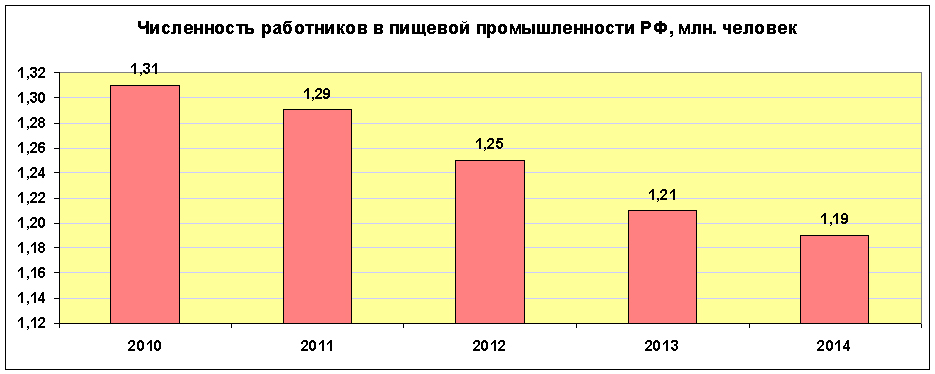
The food industry in Russia includes about 30 different industries and subsectors. The main ones are: food-flavoring, meat and dairy, flour-and-cereals and fish industries. The largest industry is the food industry, employing 63% of the workers (together with the flour and cereals industry). The second place is occupied by the production of dairy products and cheese making - 17% of employees. The meat and fish industries employ 13 and 7% of workers, respectively.
Already during cultivation, grasses can be contaminated with soil microbes or contaminated water as a result of secondary infection through improper collection, inadequate hygiene during processing and inadequate drying, storage or transportation. However, regardless of the source of microbial contamination, contaminated raw materials can adversely affect the health of the consumer. The elderly, the weak and children are especially vulnerable. Medicinal herbs or spices are often added to food after cooking and are no longer heat-treated, and, unfortunately, some microbes, even after long-term storage of dried raw materials and low water activity, can survive and cause food poisoning.
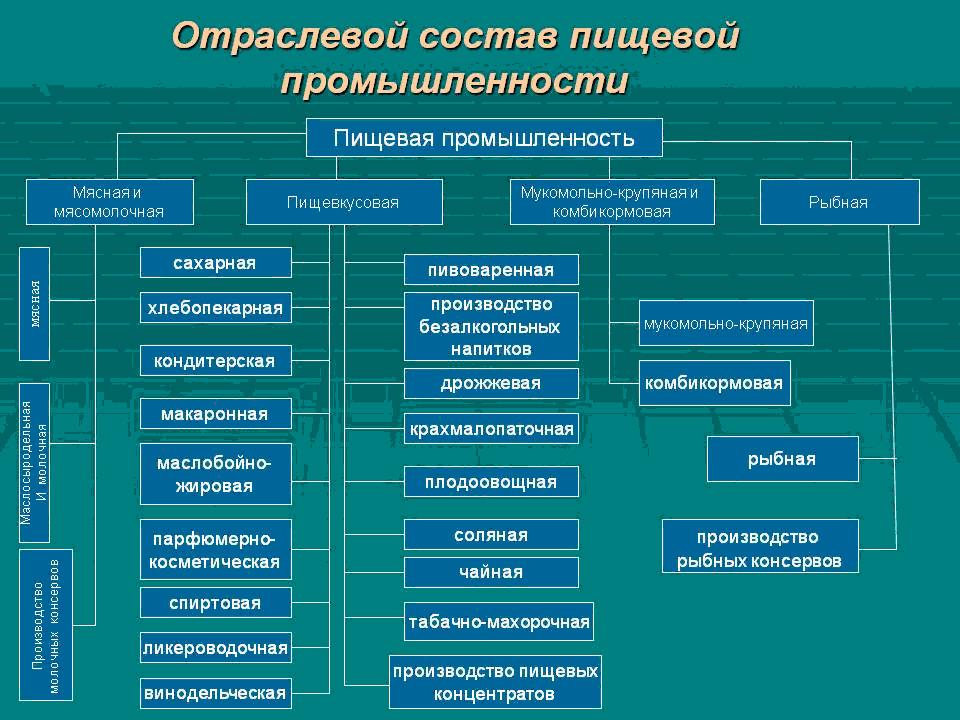
Export and
The food industry in Russia is one of the strategic sectors of the economy. Her strategic importance emphasizes the fact that every resident of Russia is a consumer of food products and one of the tasks of having a national security status is to provide their own citizens with the necessary food products, regardless of imports.
An improper drying process, storing too thick a layer of undeveloped plant material very often contributes to the development of mold. Pedigree mushrooms are extremely dangerous due to their secondary metabolites, mycotoxins. Mycotoxins can cause allergies, acute and chronic food poisoning and exhibit teratogenic and carcinogenic effects.
These companies are also required to provide their financial results for at least three years. In the Union, less than average than the contribution of small and medium industrial enterprises Poland in food production, which is associated with a smaller share of both sales and employment, but the share of medium-sized enterprises in employment in Polish companies is higher than the Union average, although sales were 2 percentage points lower. In Poland, the process of concentration of the food industry continues, but its pace is much slower than in previous years.
In the late 80s and early 90s, the food industry of the USSR, and after the Russian Federation, provided domestic products by 90%. But in the future, the share of imported products grew. In some years, the volume of imported products accounted for 60% of the Russian market. Now the situation has stabilized and imports are gradually decreasing, but their share is still very high. In 2014, the share of imported goods in the Russian food market was 34%.
The dynamic development of a functional food market, concern for the quality of food, the philosophy of slow eating and growing consumer knowledge are focusing manufacturers on meeting the needs of not only nutrition, but also health. Unfortunately, the consumer is exposed to a lot of false information from food manufacturers or distributors who can point to a product that works better for a product than for another manufacturer's product. So let's ask the question of whether a superfood is simply a marketing promise of a product that minimizes our mistakes associated with abnormal diets and lifestyles, and that promotes longevity and longevity, no matter scientifically.
As for export, although it is more than 3 times lower than import in monetary terms, it has a rather impressive turnover. At the end of 2014, the export of products of the Russian food industry amounted to USD 11.47 billion, the amount of imported food products for the same period in the Russian Federation amounted to USD 36.25 billion. Compared to 2013, exports increased by 3.1%, while imports decreased by 9.6%.
It is worth noting that the world market often points to the "supernatural" properties of food, which are not supported by reliable scientific research. Already in ancient cultures there was tremendous knowledge about the possibilities of using plants for the treatment of many diseases, and Hippocrates was credited with: "Let food be your medicine and medicine for food." Over the centuries, unfortunately, there has been a loss of knowledge that modern civilization is beginning to reopen.
After 15 rounds of negotiations1, negotiations on the Transatlantic Trade and Investment Partnership have been suspended and it is difficult to predict when and when they will resume. The final agreement will consist of twenty-four chapters, grouped into these three parts. None of the chapters will be fully devoted to issues related to the agri-food sector. However, these issues will be regulated, in particular.

In customs statistics, food products are divided into 17 groups. In 2014, imports by product group were as follows:
- Meat and edible meat offal - 5.53 billion USD.
- Fish and crustaceans, molluscs and other aquatic invertebrates - 2.56 billion USD.
- Dairy products, bird eggs, natural honey and other products of animal origin - 3.9 billion USD.
- Vegetables and edible root crops - 2.96 billion USD.
- Fruits and nuts - 5.48 billion USD.
- Coffee, tea and spices - 1.3 billion USD.
- Products of the flour and cereals industry - 0.19 billion USD.
- Fats and oils of vegetable and animal origin and their breakdown products - 1.24 billion USD.
- Finished products from meat, fish, molluscs and other aquatic invertebrates - 0.69 billion USD.
- Sugar and sugar confectionery - 0.81 billion USD.
- Cocoa and products from it - 1.38 billion USD.
- Finished products from grain, cereals, flour, starch, milk and flour confectionery - 1.28 billion USD.
- By-products of vegetables, fruits, nuts - 1.6 billion USD.
- Alcoholic and non-alcoholic drinks - USD 3.07 billion.
- Other food products - USD 1.76 billion.
- Remains of food processing and animal feed - USD 1.28 billion.
- Tobacco products - 1.21 billion USD.
The largest imports continue to be meat, fish, dairy products, fruits, vegetables, and alcoholic and non-alcoholic beverages. Compared to 2013, imports of meat and meat products decreased by 22.1%, fish and shellfish by 11.7%, dairy products by 13.8%, fruits by 17.1%, alcoholic and non-alcoholic beverages by 11.1%. On the contrary, the import of vegetables increased, the growth was 2.4%.
At the last meeting of the Committee of Experts on Environmental and Industrial Pollutants in February this year, Surprisingly, the European Commission presented to the representatives of the member states participating in the meeting a legal opinion, in the light of which it would be impossible to make all the originally planned changes.
Shortbread cookies are fatty sources high in saturated fatty acids and sometimes trans isomers. Most growers have reported using vegetable fat without specifying a specific plant name. 15.5% of the labels analyzed reported hardened fat use and 15% palm oil. Cookies can be fatty and lack nutrients in the diet. Tallow has a high energy value - 1 g of fat provides up to 9 kcal, and 1 g of protein or sugar provides about 4 kcal.

As for the export of products of the Russian food industry, the data for the main groups are as follows:
- Meat and edible meat offal - USD 0.18 billion.
- Fish and crustaceans, molluscs and other aquatic invertebrates - 2.87 billion USD.
- Dairy products, bird eggs, natural honey and other products of animal origin - 0.33 billion USD.
- Vegetables and edible roots - 0.24 billion USD.
- Fruits and nuts - 0.08 billion USD.
- Coffee, tea and spices - 0.14 billion USD.
- Products of the flour and cereals industry - 0.18 billion USD.
- Fats and oils of vegetable and animal origin and their cleavage products - USD 2.26 billion.
- Prepared products from meat, fish, molluscs and other aquatic invertebrates - USD 0.17 billion.
- Sugar and sugar confectionery - 0.26 billion USD.
- Cocoa and products from it - 0.65 billion USD.
- Finished products from grain, cereals, flour, starch, milk and flour confectionery - 0.62 billion USD.
- By-products of vegetables, fruits, nuts - 0.27 billion USD.
- Alcoholic and non-alcoholic drinks - 0.55 billion USD.
- Other food products - USD 0.61 billion.
- Remains of food processing and animal feed processing - USD 1.23 billion.
- Tobacco products - 0.81 billion USD.
The most important in Russian food exports are three groups: fish and shellfish, fats and oils, and waste from the food industry and animal feed. These three groups account for 55% of all Russian exports. Compared to 2013, the export of fish and shellfish increased by 2%, fats and oils by 3.5%, processing residues and animal feed by 15.5%.
Excessive consumption can lead to obesity, followed by abnormal blood flow, diabetes. In the prevention of obesity and other diseases of civilization, the quantity and quality of consumed fats is of particular importance. Permanent confections are high in fat and are popular with consumers, in part for their variety and availability, long term storage and fast consumption anywhere.
The paper presents a visualization of the flow of food solution through a gear pump. The study was carried out on a developed stand for a qualitative assessment of the phenomena that occur during the operation of a gear pump. The test used glucose syrup with a viscosity of 15 Pa s at 22 ° C with hexagonal polyester film particles. In the course of the flow, the phenomenon of vortex formation occurs in the interstitial space and twists at the moment of teeth engagement. In addition, there was a phenomenon of non-interdependence between spaces, which leads to a decrease in the efficiency of the positive displacement pump.
![]()
The largest gap between imports and exports falls on fruits; they are imported into the country, in an amount that exceeds exports by 68.5 times. There is also a very big difference between the export and import of meat and meat products - 30 times. Exports of dairy products and vegetables exceed imports 12 times.
In Poznan in the Research and Development Group of Machines and Food Industry. The study analyzed the operation of a gear pump, which is used in industry. for pouring liquid chocolate. Imaging tests performed in a qualitative manner indicate the phenomena that occur during the operation of the gear pump. Because of the purpose of the imaging station, it was made of transparent components, including a transparent displacement pump, suction and discharge hoses, and a fluid container that sat above the pump under test.
In turn, imports of fish and shellfish, as well as fats and oils of animal and vegetable origin, exceed exports by 1.12 and 1.82 times, respectively. The parity between imports and exports is maintained in the products of the flour and cereals industry and the remnants of the processing of the food industry and animal feed.
Production of meat and meat products
The meat industry has a close relationship with agriculture and is highly dependent on the work of livestock enterprises. Unfortunately, the meat industry in Russia is very dependent on imports of products, and also has a low level of processing of raw materials.
Modernization processes have made it possible to meet the required veterinary standards, and the production has been adapted to market requirements. Structural changes have led to an increase in concentration both in the raw material base and in the dairy industry. As a result, economic efficiency and labor productivity have improved. The dairy industry is competitive on foreign markets as it has a large positive foreign trade balance. The financial position of the industry is good, but depends to a large extent on the world market, as exports play a large role.
In total, by the end of 2014, just over 310 million tons of meat were produced in the world. Pork has the largest share in world production - 37%, which in quantitative terms is 115.5 million tons.
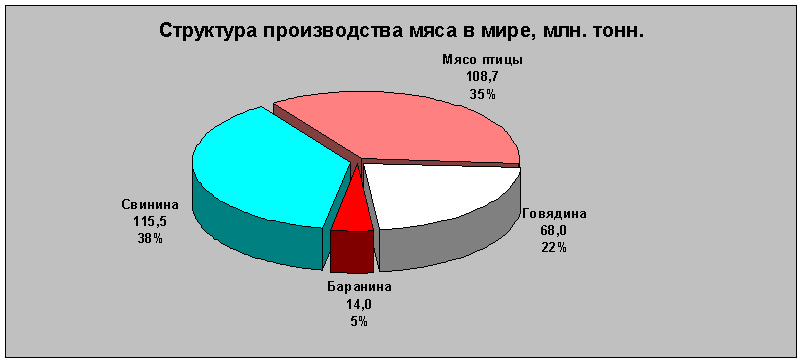
As for meat production in Russia, in 2014 production growth amounted to 8.5%, which in quantitative terms is equal to 5.81 million tons. At the same time, the structure of meat production in Russia differs significantly from the world one. More than 66% of the produced meat is poultry, which is equal to 3.88 million tons. Meat of slaughter animals was produced 1.93 million tons, of which 75% is pork, 13% is beef, about 0.5% is mutton, and 11.5% is the rest of the meat.
![]()
Although meat production in the Russian Federation is increasing every year, in terms of per capita consumption of this product, Russia lags far behind European countries and the United States. So in the USA, the country where the consumption of meat is the largest in the world, this figure is about 120 kg. meat per capita per year, in Europe the average consumption of meat is 90 kg per person per year. In the Russian Federation, per capita meat consumption is 65 kg. in year.
In addition to meat production, the meat industry produces various semi-finished meat products, sausages and canned meat. Along with the growth in meat production, there is an increase in meat products. So in 2014 were produced:
- Chilled semi-finished meat products - 981 thousand tons.
- Frozen semi-finished meat products - 1 691 thousand tons.
- Sausage products - 1,616 thousand tons.
- Sausage products from thermally processed ingredients - 89.3 thousand tons.
- Smoked sausage products - 652 thousand tons.
- Canned meat - 611 million cans.
- Canned meat and vegetable - 115 million cans.
At the end of 2014, the largest growth was recorded in the production of chilled semi-finished products - 13.8%. The only product that was produced less than in 2013 is smoked sausages. The drop in production was 2%.
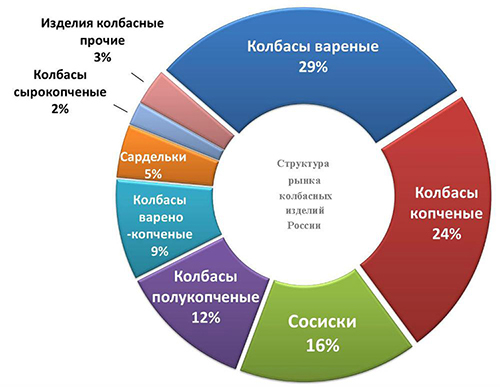
Today, the enterprises of the meat-processing industry of the Russian Federation produce more than 170 types of various products. The largest meat processing plants in Russia:
- Ostankino Meat Processing Plant OJSC - 180 thousand tons of products per year.
- Meat processing plants of the Cherkizovo group - 145 thousand tons of products per year.
- Mikoyanovsky Meat Processing Plant (EXIMA) - 140 thousand tons of products per year.
- Meat processing plant "Dubki" - 125 thousand tons of products per year.
- Tsaritsyno group of companies - 110 thousand tons of products per year.
Dairy industry
Milk is a very important product in the diet of Russians. Every year, each inhabitant of the Russian Federation consumes about 230 kg on average. milk and dairy products. According to this indicator, the Russian Federation is in 12th place, and France and Germany are in the lead, in these countries the consumption of dairy products reaches 425 kg. in year.
Unfortunately, this dairy food industry, like the meat industry, is highly dependent on imports. Today the main suppliers of dairy products to Russia are Finland, the Baltic countries and Belarus. Also, the Russian market has a large share of imported cheeses that are imported from Western Europe.
2014 was characterized by the fact that the second half of the year, Russian dairy enterprises had to work under a food embargo. At the same time, the anti-sanction policy of the Russian authorities pushed Russian manufacturers to increase volumes, since it was necessary to fill the niche of imported products. At the beginning of 2014, the share of imported products on the Russian market in the cheese segment was 50%, butter - 37%, milk powder - 32%. In general, the main segment of the dairy market in Russia is whole milk products, which are significantly ahead of other segments, and the best-selling dairy products in Russia are kefir and yogurt.
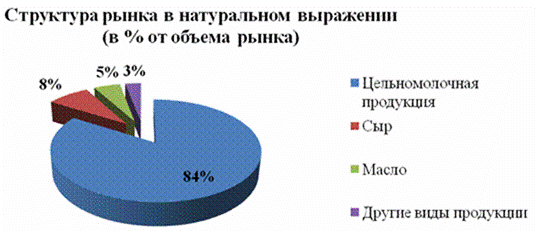
In 2014, Russian enterprises produced 5,317 thousand tons of processed liquid milk. This is 1.3% less than in 2013. But for the production of basic dairy products, there was a significant increase. The largest increase by 2013 was recorded in the milk powder segment - 30%.

The leader of the Russian dairy market is Wimm-Bill-Dan. The structure of the company includes 36 enterprises that, in addition to dairy products, produce soft drinks, mineral water and juices. In 2011, Wimm-Bill-Dan was bought by the Pepsico concern, which today is the largest food and beverage manufacturer in Russia.
Other large companies branches - OJSC "Ochakovsky dairy plant", "Permmoloko", "Unimilk", "Danone", "Erman".
Fishing industry
The fishing industry of Russia is a diversified production and economic complex, which includes enterprises for the extraction and cultivation of aquatic biological resources and their processing. Today, the fishing industry of the Russian Federation produces more than 2,500 types of various products.
The fishing industry is one of the few food industry sectors in which exports exceed imports. But, unfortunately, it is necessary to recognize the fact that Russia mainly supplies raw materials for processing, and not finished products. This is due primarily to the low technical level of domestic enterprises.
For comparison, in Japan a product worth $ 2,580 is produced from one conventional ton of biological resources, in Norway, under the same conditions, for $ 1,765, in the USA - for $ 1,350, and in Russia this figure is only $ 760. Thus, when exporting the same amount of biological resources to the world market, Russian companies have 3.4 times less than their Japanese counterparts.
On average, about 180 million tons of fish are caught in the world annually. The leader in this indicator is China, which accounts for almost 40% of the total world catch. Russia ranks 9th with 4.2 million tonnes.
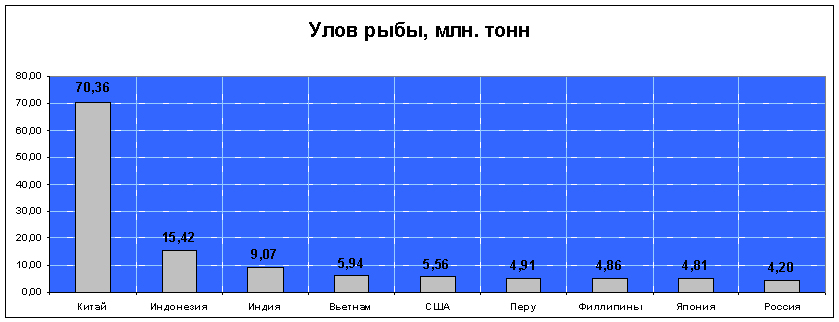
At the end of 2014, the catch in Russia, compared to 2013, decreased by 1.9%. At the same time, the volume of catch of marine biological resources decreased by 2.2% and amounted to 4.068 million tons.
The structure of the fishing industry in Russia employs 8.5 thousand organizations, which employ 60 thousand people. The industry's profitability is 16.5%. Most of all, the Russian fishing industry catches and processes cod fish, as well as fish from the salmon, herring and carp families.
In 2014, fish processing enterprises in Russia produced 3,644 thousand tons of products. This is 4% less than in 2013, and in general, fluctuations in production indices in this food industry have not exceeded 5% in recent years. Over the past year, 584 million conventional cans of canned fish were produced in Russia. Most of all produced natural canned fish - 195 million conventional cans, which is 16 million cans less than in 2013. The decline also affected the production of canned fish in oil - (- 5%) compared to 2013. But on the other hand, the production of canned fish in tomato and preserves of cut fish in various fillings increased by 15.5 and 11.2%, respectively.
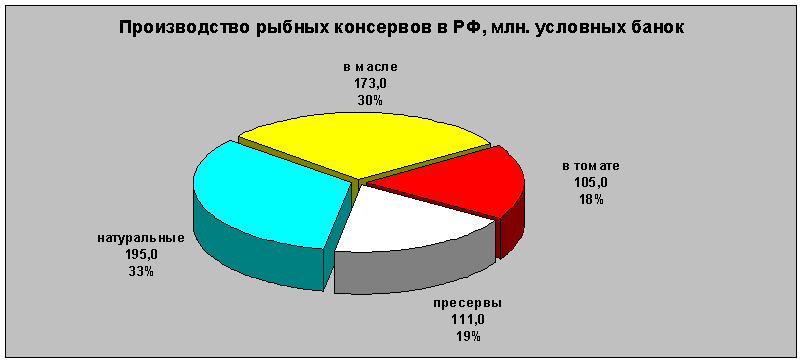
The main place for fishing in Russia is the Far East basin. In 2014, 2.7 million tons of fish were caught here, which is 64.2% of the total Russian catch. At the same time, out of 2.7 million tons, about 55% fell on the pollock catch.
In second place in terms of fish catch is the Northern Basin, 619 thousand tons of fish were caught here, of which 515 thousand tons were cod. In addition, 78 thousand tons of haddock and 26 tons of capelin were caught.
In other waters of Russia in 2014, the fish catch was:
- Azov-Black Sea basin - 51 thousand tons.
- Baltic basin - 47 thousand tons.
- Caspian basin - 36 thousand tons.
Also in the zones of foreign states Russian companies 504 thousand of aquatic biological resources were extracted and 211 thousand tons in the open part of the World Ocean.
Production of beer and alcoholic beverages
The market for alcoholic and low-alcohol products in the Russian Federation is shrinking every year. This is primarily due to the programs of the government of the Russian Federation, which are aimed at reducing the consumption of alcoholic products by the citizens of the country. According to Rosstat, the average consumption of alcoholic beverages per person per year in Russia is 18 liters in terms of absolute alcohol. Moreover, due to the reduction in the alcohol market, slightly less than half of 8.24 liters, falls on the consumption of unauthorized alcohol-containing products and home-made products.
If we recalculate 18 liters of absolute alcohol for alcoholic beverages, then it turns out that the average consumption of alcohol per year by one Russian is equivalent to 90 half-liter bottles of vodka or 720 bottles of beer or 214 bottles of wine with a capacity of 0.7 liters. But in terms of beer consumption per person, Russia takes 17th place in the world with an indicator of 74.1 liters, 2 times behind the leader - the Czech Republic.
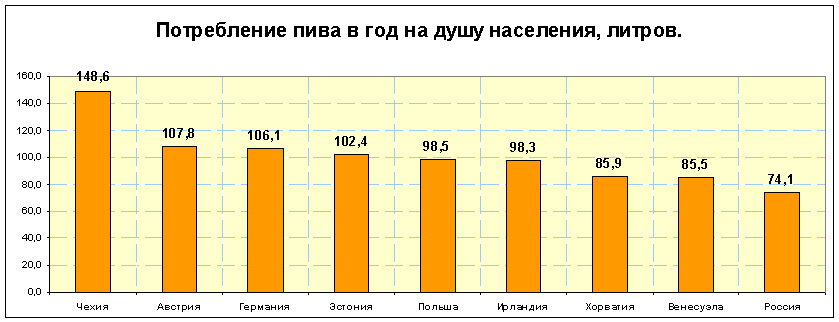
In 2014, as experts predicted, the beer market in Russia shrank by 7%. At the same time, beer production by Russian companies, compared to 2013, decreased by 8.3% and amounted to 816 million decaliters. And in general, beer production in Russia, starting from 2010, has been decreasing every year, over the past 5 years the decline in production volumes amounted to 21.8%.
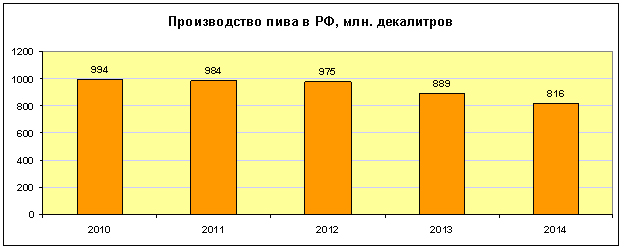
In addition to beer, in 2014, the output of alcoholic beverages of increased strength decreased significantly. Thus, the production of vodka in Russia amounted to 66.6 million decaliters, which is 22.3% less than in 2013, and the production of cognacs decreased by 7.8% and amounted to 6.9 million decaliters. The production of sparkling wines decreased by 9.5% to the level of 15.6 million decaliters, while the production of table wines amounted to 32.1 million decaliters, which is 3.9% less than in 2013.
In the structure of consumption of alcoholic beverages by Russians, vodka and alcoholic beverages hold the lead, accounting for 42% of all consumption. The second place in terms of consumption is beer - 40.8%.

The industry leader is the Baltika Brewery, which is part of the Carlsberg Group. The company exports its products to 75 countries of the world and occupies 37.7% of the Russian beer market. In Russia, Baltika owns 8 breweries.
Other large enterprises in the industry are CJSC Sparkling Wines, OJSC Moscow Sparkling Wine Factory, CJSC Abrau-Dyurso, CJSC Topaz Distillery.
Oil and fat production
Like the fish industry, fat and oil production is the branch of the Russian food industry, in which the volume of exports exceeds the volume of imports. The main products of the production of fat and oil industry are; vegetable oil, margarine and fats, mayonnaise.
Vegetable oil production accounts for 75% of production, in the total quantitative volume of production of the fat and oil industry. In 2014, Russia produced 4,782.8 thousand tons of vegetable oil, which is 23.4% more than in 2013.

In Russia, sunflower oil is the main one for home consumption. The annual consumption of sunflower oil per capita is 10 - 11 kg. And although this figure is increasing every year, the consumption of this product in Europe and the United States is much higher and amounts to 23-26 kg. in year.
The leader of the Russian sunflower oil market is the Yug Rusi company, which owns about 30% of the Russian market. The trade marks of this company are "Avedov", "Zolotaya Semechka", "Zlato", "Yug Rusi". The second place with 7.4% of the market is shared by Bunge and Aston.
In 2014, the production of margarine products amounted to 1 million tons, this figure exceeds the last year by 14.3%. The main consumers of these products are other sectors of the food industry, including: confectionery, dairy, bakery, canning.
![]()
Mayonnaise is one of the most common industrial sauces. Russia is one of the leaders in the world consumption of mayonnaise, the average Russian consumes about 5 kg per year. mayonnaise, while in European countries this figure is about 2-2.5 kg. in year. The Russian mayonnaise market accounts for 35% of the world market, and in the domestic market, various types of mayonnaise make up 70% of all sauce products in kind. By comparison, ketchup and other tomato sauces only account for about 18% of the market.
Mayonnaise production in 2014 in Russia amounted to 846.6 thousand tons, which is 0.9% more than in 2013. And the market leader is Essen Production AG with the Maheev trademark, which accounts for 15.8% of all products consumed. The top three also include the Sloboda trademark from EFKO, which holds 11.5% of the market, and Moskovsky Provencal from Solnechnye Products, with a 7.4% market share.

Confectionery industry
Confectionery is a high-calorie, high-sugar food. The confectionery market of the Russian Federation is one of the most capacious in the world. On average, Russians consume about 25 kg. confectionery products annually, with about 12 kg. of this number falls on chocolate products.
In 2014, Russian confectionery enterprises produced 3,651 thousand tons of products. This is 6.78% more than in 2013. In general, confectionery has enjoyed a positive growth over the past 5 years.
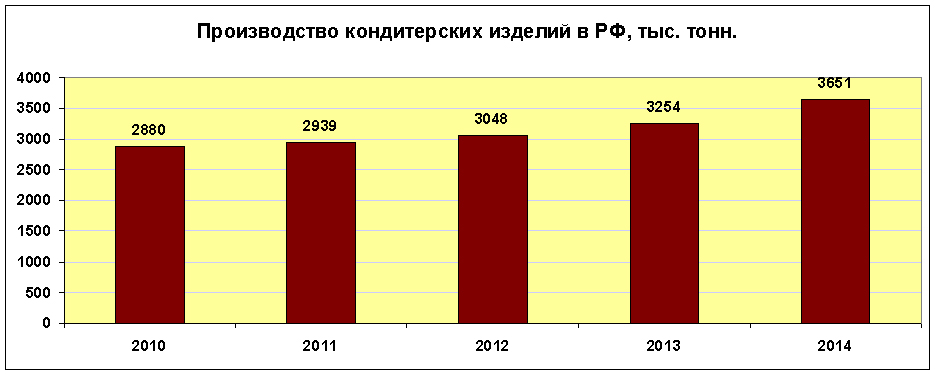
In total, there are about 150 large confectionery enterprises and about 1200 small ones operating in Russia. In total, the industry employs about 100 thousand people. There are enterprises in all Federal districts, but the leader in the production of confectionery is Central Federal district, it accounts for about 40% of all manufactured products. And the structure of the issue by districts of the Russian Federation looks like this:
- Central Federal District - 1,460.4 thousand tons;
- Volga Federal District - 730.2 thousand tons;
- Siberian Federal District - 438.1 thousand tons;
- Northwestern Federal District - 401.6 thousand tons;
- Southern Federal District - 292.1 thousand tons;
- Ural Federal District - 255.6 thousand tons;
- Far Eastern Federal District - 36.5 thousand tons;
- North Caucasian Federal District - 36.2 thousand tons.
The leader of the confectionery industry in the Russian Federation is the Mars company; at the end of 2014, the company's revenue amounted to 72.2 billion rubles. The company manufactures products under the well-known world brands "Twix", "Mars", "Dove", "Snickers", etc.
The second place in 2014 was taken by the LLC "Mondelis Rus", its revenue amounted to 55.3 billion rubles. The company manufactures products of the Picnic, Milka, Alpen Gold, Barney and other brands.
Wrigley LLC closes the top three with a turnover of 18.27 billion rubles. The main products of the company are chewing gum, candies and lollipops.
Food industry
Food industry
a set of industries that produce food. Includes dairy, meat, fish, butter, butter, flour, bakery, sugar, confectionery, canning and other industries. It is closely related to agriculture and fishing, since it receives raw materials from these industries (milk, meat, fish, seafood, vegetables, fruits), part agro-industrial complex... Some food industry enterprises operate on imported raw materials and are not directly related to the raw material base; the products they produce do not require immediate consumption and are highly transportable. These are confectionery factories, meat processing plants, etc. The scale of such industries is significant. Others, smaller in scale, are guided by raw materials (sugar, canning, butter-cheese, etc. factories) and are close to resource bases... Still others are consumer-oriented (bakery industry, production of semi-finished products, etc.) and are close to the places where products are sold. The modern food industry is characterized by the broadest mechanization and automation of production and transport processes, the use of artificial cold and vacuum technology, the latest physical methods (ultrasound, high-frequency heating, etc.), chemical and biological drugs to accelerate technological processes, a huge variety of new products ( e.g. baby and diet food). New methods of long-term (up to several weeks) preservation of products (bread, etc.) in a sealed airtight container are promising. New effective, environmentally friendly chemical and biological preservatives have been found. Delivery of almost any industry product to any part of the world is possible. The food industry includes, in addition to the food industry itself, the production of non-alcoholic and alcoholic beverages (including the alcoholic beverage industry, winemaking, brewing) and tobacco products.
Geography. Modern illustrated encyclopedia. - M .: Rosman. Edited by prof. A.P. Gorkina. 2006 .
See what "food industry" is in other dictionaries:
Industry light industry, the totality of food production in finished form or in the form of semi-finished products. In system agro-industrial complex the food industry is closely related to agriculture as a supplier of raw materials and with ... ... Financial vocabulary
A set of industries producing food products: meat, dairy, fish, flour-grinding cereals, bakery, sugar, confectionery, canning, fatty oil, etc. Big Encyclopedic Dictionary
food industry- - EN food industry The commercial production and packaging of foods that are fabricated by processing, by combining various ingredients, or both. (Source: MGH) ... ... Technical translator's guide
Packaged food in the American supermarket Fred Meyer Food industry The totality of food production in finished or semi-finished form ... Wikipedia
A set of industries producing food products: meat, dairy, fish, flour-grinding cereals, bakery, sugar, confectionery, canning, fat and oil, etc. * * * FOOD INDUSTRY FOOD INDUSTRY, a set of industries ... encyclopedic Dictionary
I Food industry - the totality of industries producing food flavors, as well as tobacco products, soap and detergents, perfumery and cosmetic products. In pre-revolutionary Russia, there were over ... Great Soviet Encyclopedia




